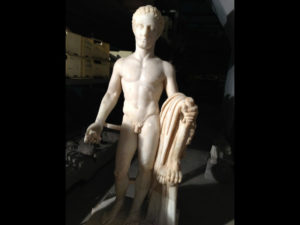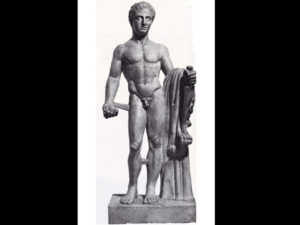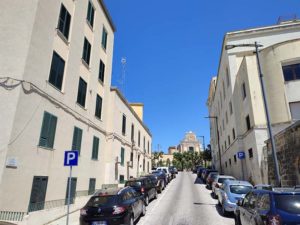Ercole, padre di Brento il leggendario fondatore della città di Brindisi
Via Ercole brindisino, dal luogo di ritrovamento della sua statua nel 1762; Ercole fu padre di Brento, leggendario fondatore della città di Brindisi; i brindisini nell’antichità professarono il culto di Ercole.
Il nome di questa strada ricorda il ritrovamento, qui nei pressi, di una statua di marmo bianco del I sec. rappresentante Ercole da giovane, che ha nella mano destra i pomi d’oro delle Esperidi e con l’altra stringe un arco spezzato, mentre la pelle del leone Nemeo pende dal braccio sinistro.
La statua fu casualmente ritrovata nell’ottobre 1762 in largo S. Paolo, in occasione di lavori di scavo, unitamente a una cassa contenente molte monete d’argento. Prima che fosse trasferita nel Museo Archeologico di Napoli, su disposizione del re Ferdinando IV Borbone, il Municipio brindisino ne fece fare un ritratto su tela, oggi esposto nella Biblioteca provinciale, che ha la seguente iscrizione dettata da Ortensio De Leo, letterato e studioso di storia locale, zio del più noto Annibale (Arcivescovo di Brindisi dal 1797 al 1814):
Herculis Defensoris/ Brundisinorum Olim Praecipui Hominis/ Brenti Herois Urbis Denominatoris/ Dii Patris/ Simulacrum E Candido Marmore/ In D. Paulli Templi Area/ Cum Ingenti Augg. Augustarum Q./ Nummorum Antiquor Argenti Copia/ Non. Octob. A. S. MDCCLXII/ Forte Effossum/ Ferd. IV P. F. Neap. Regis Iussu/ Ob Eius Elegantiam Asportatum/ Suoq. Museo Positum/ Ordo P. Q. Brund./ Servand., Patriae/ Vetustatis Monumentu/ Exemplari In Curia Nobilium/ Collocari P. D.
La statua in marmo bianco del protettore Ercole, padre dell’eroe Brento che diede il nome alla città di Brindisi, venuta casualmente alla luce il 7 ottobre 1762 nel largo S. Paolo, insieme a un gran numero di monete d’argento di Augusti e Auguste, per ordine di Ferdinando IV felicemente regnante fu trasferita a Napoli e collocata nel suo museo. Il decurionato e il popolo di Brindisi, per conservare il ricordo del monumento pregevolissimo per l’antichità, decisero che fosse riprodotto su tela, da esporre al pubblico nella sala delle adunanze.
La statua ha una grande importanza storica, più che artistica. Con Nettuno, Apollo e Diana, Ercole, infatti, è stato una delle maggiori divinità cui i brindisini hanno professato a lungo il loro culto. Una delle ipotesi leggendarie sull’origine del nome di Brindisi è che esso derivi da Brento, figlio di Ercole.
Note bibliografiche:
– Alberto Del Sordo, Toponomastica brindisina, il centro storico, Schena ed., Fasano (Br) 1990
Ercole, father of Brento the legendary founder of the city of Brindisi
Via Ercole Brindisino”, name deriving from the place of discovery of the sculpture, in 1762. Hercules was the father of Brento, the legendary founder of the city of Brindisi. People of Brindisi, in ancient times, professed the cult of Hercules.
The name of the street recalls the discovery, nearby, of a white marble statue of the I century. It represents the young Hercules, holding in the right hand the Hesperides’ golden apples and, in the other hand, a broken bow. Moreover, the skin of the Nemean lion hangs from the left arm.
Herculis Defensoris/ Brundisinorum Olim Praecipui Hominis/ Brenti Herois Urbis Denominatoris/ Dii Patris/ Simulacrum E Candido Marmore/ In D. Paulli Templi Area/ Cum Ingenti Augg. Augustarum Q./ Nummorum Antiquor Argenti Copia/ Non. Octob. A. S. MDCCLXII/ Forte Effossum/ Ferd. IV P. F. Neap. Regis Iussu/ Ob Eius Elegantiam Asportatum/ Suoq. Museo Positum/ Ordo P. Q. Brund./ Servand., Patriae/ Vetustatis Monumentu/ Exemplari In Curia Nobilium/ Collocari P. D.
The statue was found randomly, together with many silver coins, in October 1762 in “Largo s. Paolo” thanks to excavation works. Before relocating it in the Archeologic Museum of Naples, on order of the King Ferdinand of Bourbon IV, the Municipality of Brindisi ordered to portray the statue on canvas, today exhibited at the Provincial library. The canvas bears the inscription dictated by Ortensio de Leo, scholar of local history and uncle of the best-known Anibal (Archbishop of Brindisi between 1797 and 1814):
Herculis Defensoris/ Brundisinorum Olim Praecipui Hominis/ Brenti Herois Urbis Denominatoris/ Dii Patris/ Simulacrum E Candido Marmore/ In D. Paulli Templi Area/ Cum Ingenti Augg. Augustarum Q./ Nummorum Antiquor Argenti Copia/ Non. Octob. A. S. MDCCLXII/ Forte Effossum/ Ferd. IV P. F. Neap. Regis Iussu/ Ob Eius Elegantiam Asportatum/ Suoq. Museo Positum/ Ordo P. Q. Brund./ Servand., Patriae/ Vetustatis Monumentu/ Exemplari In Curia Nobilium/ Collocari P. D.
The white marble statue of Hercules the protector, father of Brento the hero, who gave his name to the city of Brindisi, casually come to light on the 7th of October 1762 in “Largo S. Paolo”, together with a large number of silver coins of Augusts. On order of the King Ferdinand of Bourbon IV, the statue was relocated to Naples and placed in his museum. The decurionate and the citizenship of Brindisi decided to portray the statue on canvas, exposing it in the assembly hall, to preserve the memory of the ancient and very valuable monument.
The statue has historic value, more than artistic one. Effectively, together with Neptune, Apollon and Diane, Hercules has been one of the most venerated divinities in Brindisi. To this extent, a legend traces the origins of the name of Brindisi to Brento, son of Hercules.
Bibliographic notes:
– Alberto Del Sordo, Toponomastica brindisina, il centro storico, Schena ed., Fasano (Br) 1990




